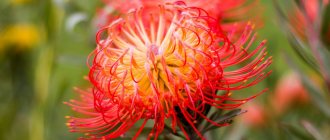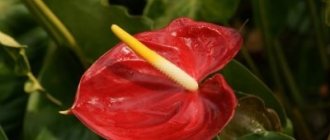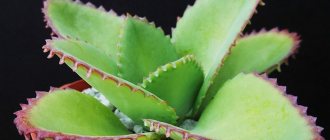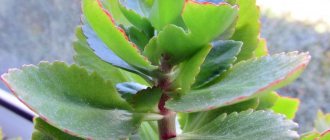The coffee tree (Coffea) is an evergreen tree plant that belongs to the Rubiaceae family. The plant produces rich burgundy fruits with seeds and grains. Such a tall shrub in the wild can reach a height of 8 to 10 m. Opposite large leaf plates are leathery to the touch. The color of the inflorescences is cream or white. In cultivation, the plant is shortened to a height of 150 to 250 cm. This makes it much easier to care for and harvest.
This shrub is native to tropical Ethiopia. It has an average rate of growth and development, with its annual growth being 50–100 mm per year. The lifespan of such a perennial is directly related to how favorable the climatic conditions are for its growth. Science knows of coffee trees that are more than 100 years old, and they never stop bearing fruit.
Flowering of this plant is observed in April–October. After this, fruits are formed on the branches, which can be eaten. The coffee tree blooms and bears fruit for the first time at the age of 3–4 years.
Brief description of cultivation
- Temperature . In the spring-summer period - from 20 to 30 degrees, and in winter - from 12 to 15 degrees.
- Air humidity . Should be increased (approximately 70 percent).
- Illumination . Supplementary lighting or diffused sunlight. The best option for the plant is a western or northern window sill.
- Watering . The substrate is moistened with well-settled softened water. In the warm season, watering is carried out once every couple of days (at least), and in the winter months - after the top layer of the soil mixture has dried.
- Substrate . Should be slightly acidic. A high-quality drainage layer is made at the bottom of the pot.
- Fertilizer . Fertilizing with organic fertilizer is carried out once every 15 days. At the same time, mineral fertilizers are added to the substrate once every 2 weeks.
- Transplant . It is carried out only when the roots no longer fit into the pot (approximately once every 3 years).
- Reproduction . Seed and vegetative methods.
- Features of care . The plant reacts extremely negatively to even a small draft and stagnation of moisture in the roots. In winter, the bush needs rest, and it is removed away from operating heating devices.
Coffee tree: how to properly care for and replant
Diseases
It is not so much dangerous for the plant to over-moisten the soil as to have excessive dry air. Diseases of the coffee tree are reduced to damage by spider mites. During the cold season, it can become infected with scale insects. For prevention, it is necessary to eliminate drafts and maintain constant air humidity (warm, damp shower, spraying). Infections with coffee rust, bean borer, and sooty fungus may also occur.
Important! For any disease, damaged leaves are removed and treated with appropriate medications.
It should also be remembered that coffee is a tropical plant that is not adapted to life in temperate and cold climates. Therefore, a room temperature below 15° can be detrimental to the tree. A thin black border appears on the foliage. Then the leaves completely darken and the tree quickly dies.
Like any exotic plant, the coffee tree needs close care and attention. But the efforts of plant growers do not go unrewarded. The aroma of spring flowering coffee buds knows no competition. And the fruits that appear with good care already in the fourth year will be a real gift.
Caring for a coffee tree at home
Temperature
In indoor conditions, the coffee tree develops best and grows at an air temperature of about 23 degrees. However, if the room temperature is higher than this value, the plant will not be harmed; the main thing is to monitor the optimal level of air humidity.
In winter, the bush should rest. To do this, it is transferred to a cool place - from 12 to 15 degrees.
Air humidity
During the hot and dry summer months, coffee is moistened every day from a spray bottle with well-settled soft water. Once every 30 days, it is recommended to use an ash infusion to spray the bush, which is used to prevent the occurrence of diseases and pests. In the cold season, it is highly not recommended to moisten the foliage. Spraying is carried out only if the bush is standing next to a working heating device.
Illumination
The domestic coffee tree is not light-loving. It does not need direct sunlight, so northern and western windows are ideal for growing it. If necessary, the bush can be placed not on the window, but near it.
However, if the coffee is constantly in the shade, this may cause a lack of flowering. In this case, he needs to provide additional lighting.
Watering
The coffee tree is an exotic tropical plant. But despite this, it reacts negatively to excessive watering and stagnation of water in the pan. However, the plant can also be harmed by drying out the earthen ball in the pot.
If you notice that the foliage on the branches has drooped, then this is a sign that the plant needs urgent watering. If the bush does not receive moisture, it may die, and it will be extremely difficult to save it.
In winter, the bush is watered approximately once every 7 days. Moreover, the substrate is moistened only after its top layer has dried.
Choosing a pot
When choosing a container for transplanting coffee, you must first of all rely on the size of its root system. If the bush grew in a small pot, then it cannot be immediately transplanted into a very spacious container. Ideally, the volume of the container when transplanting should be larger than the clod of earth with a root system by only 20–40 mm. If the pot is larger, this will lead to rapid acidification of the substrate and the appearance of rot on the root system.
Substrate
For such a crop, a slightly acidic clay soil mixture with the addition of organic matter is best suited. For planting, you can use a purchased universal soil mixture. If desired, the substrate can be prepared with your own hands; to do this, mix peat, garden and humus soil with river sand, taking all components in equal parts.
Be sure to make a good drainage layer at the bottom of the container. It will help prevent fluid stagnation in the root system. In addition to the soil mixtures described above, you can use store-bought substrate for azaleas or gardenias for replanting coffee.
Fertilizer
During the growing season, the plant needs a regular supply of additional nutrients. Timely feeding will ensure proper growth and development of the bush, while its foliage will be dense and fruiting will be abundant.
Feeding scheme recommended by experts:
- In March–May, nitrogen-containing fertilizer is added to the substrate. Next, one fertilizing is carried out with minerals and one with organic matter.
- In summer, fertilizing is carried out once every 1.5 weeks. For this purpose, monosubstituted potassium phosphate is used. At this time, organic fertilizers are not applied.
- In September, the plant is provided with foliar feeding with potassium salts.
In addition, the substrate should be regularly shed with acidified water once every 30 days: 1 g of citric acid is dissolved in 1 liter of water.
Replanting a coffee tree
If the coffee tree grows in the same container for a very long time, this may cause a deterioration in its development. That is why timely replanting is the key to abundant flowering and good fruiting.
After the bush is removed from the old pot, inspect its root system. Remove all dried and rotten roots. After this, the bush is planted in a new container filled with fresh soil mixture. Please note that after planting, the root collar of the plant should rise 0.5–0.7 cm above the surface of the substrate. Carefully fill all voids with new soil mixture.
After the transplant is completed, the substrate in the pot is well moistened with melted or settled water, which should be slightly warm. After a couple of days, the surface of the soil mixture must be loosened to ensure light moistening of the soil mixture and to prevent stagnation of moisture in the roots.
COFFEE TREE CARE AND TRANSPLANTING
Trimming
If desired, such a shrub growing at home can be systematically pruned. This will help give the crown the desired shape. If you want to grow a standard tree, then it is better not to prune the plant at all, because often after pruning the growth of shortened branches stops.
Most often, intensive branching of coffee is observed after the height of the bush is 0.5–0.8 m, and therefore the standard type is formed independently without the intervention of the grower. If the coffee tree is formed in the form of a bush, then to give the crown the desired shape, you should pluck out excess shoots.
Bloom
From April to October, the indoor coffee tree experiences a period of flowering and intensive growth. At this time, small inflorescences consisting of 4–6 white flowers are formed in the leaf axils. They have a pleasant, unobtrusive aroma that is similar to jasmine.
Please note that flowering is observed only in adult specimens. If you take good care of the plant and provide it with a dry winter, then most likely the first flowers will form on the branches in the third or fourth year of growth.
Rest period
Around October, the shrub begins a dormant period, for which it needs to create certain conditions. Rules for caring for the plant during the dormant period:
- the air temperature in the room must be within 12–15 degrees;
- the substrate in the container is moistened only after its top layer has dried well;
- The bush should be in the shade, but it needs to be illuminated every day for several hours.
In the last winter or first spring weeks, the coffee tree is moved to a warmer place. At the same time, bright sunlight is contraindicated for him at this time.
How long can I leave it without care?
If you urgently need to leave for a while, then in order to prevent the death of the coffee tree, you must first prepare it:
- It is necessary to cut off all flowers or fruits. The fact is that the plant spends a large amount of moisture on them.
- Pinch young shoots, which will stop their growth for a while.
- Before leaving, it is recommended to place the pot with the bush on a foam mat, which is located in a container of water. Please note that the drainage holes at the bottom of the container should not be very tightly plugged with foam pieces.
In addition, if possible, you can install an automatic watering device. Thanks to it, the bush will be provided with systematic access to water for 15–20 days.
How to grow an indoor coffee tree from beans at home?
Store-bought grains are not suitable for planting because they are dried so that they can be stored for a long time. Germination is lost during this treatment. For a gardener who wanted to do just this, problems begin: “Where can I get coffee beans?” You can try looking for planting material on the websites of flower shops on the Internet, or go to forums in search of like-minded people who are ready to share coffee beans.
Coffee beans.
The grain was found with great difficulty. Now, based on the opinion of professional gardeners, for whom growing coffee at home has already become commonplace, you can get down to business:
- First of all, you need to destroy the hard shell of the coffee bean. This can be done using a small nail file, knife, or file.
- Next, soak the grain in a growth stimulator (any flower shop will have a sufficient amount of such preparations).
- While the grain is swelling, you should start preparing the soil. The plant requires a loose soil mixture, which can also be picked up in the store.
- All that remains is to simply plant the grain in a flowerpot and cover it with a fairly thick layer of soil (about five centimeters).
Grain planted at home requires patient care and maintenance of the plant sprouts in certain conditions, in particular, the soil must be constantly moist, but not wet (wet is considered to be soil that turns into a lump). The room temperature should not drop below twenty degrees, otherwise it will not be possible to grow a home coffee tree from seeds. An adult perennial coffee tree needs the same temperature, and in winter it should not fall beyond twelve degrees, of course, “plus”.
Reproduction methods
Growing from seeds
If desired, a coffee tree can be grown from seeds indoors. Only freshly harvested seed material is suitable for this. The older the seed, the less likely it is for a seedling to emerge.
The substrate for sowing is loose and well-permeable to water. For example, you can use river sand mixed with leaf soil. Before starting sowing, the substrate is sterilized: for this purpose it is sterilized for 10 minutes. kept over the steam of boiling water.
The seed material is not buried, it is laid out on the surface of the soil mixture. Otherwise it may rot. The seeds should be placed flat on the surface of the substrate. Next, the crops are watered with slightly warm water. The top of the container is covered with glass or film. It is necessary to ventilate the crops regularly: to do this, the shelter is removed for three hours with a frequency of 2 times every 7 days.
25 degrees is the optimal temperature for the emergence of seedlings. In this case, the appearance of the first shoots may not occur earlier than 6–8 weeks after sowing. After the seedlings have developed several true leaf blades, they can be picked. The first fruiting of a bush grown from seeds is observed in the third or fourth year of growth.
How to grow a COFFEE TREE at home ☕
Cuttings
Last year's branches are used to prepare cuttings, and there should be 2 nodes on each segment. Before planting, the cuttings are kept in a Heteroauxin solution for several hours. Then they are planted in a mixture consisting of 1 part peat and 1 part sand. The sections are buried 30 mm into the substrate. Don't forget to make a good drainage layer at the bottom of the container.
The cuttings should be provided with the same air temperature and the same watering regime as when sowing the seeds. In order for the cuttings to grow roots faster, they need bottom heating of the container.
After the cuttings begin to grow and young leaf plates emerge from the buds, they can be planted in a permanent pot. Such bushes will bear fruit for the first time already in the second year of growth.
Coffee tree growing and propagation at home
How to plant correctly
This plant should be protected from sudden temperature changes and exposure to drafts. With proper care, the crop will bloom and bear fruit profusely.
Selection of capacity
The crop should be planted in a tall pot.
A high-quality drainage layer is of no small importance. The roots of the culture grow downwards
Soil requirements
The tree should be grown in a loose and acidic substrate. It is best to mix coarse sand, crushed coal, humus, and peat. These components are taken in equal parts.
Planting scheme
It is best to grow a crop from a grain. It should not be fried. To plant a plant, do the following:
- Soak the grain in a solution of hydrochloric acid or lightly saw it.
- Place the grain in a growth stimulator.
- Moisten and loosen the soil. Plant a seed. It should not be deepened too much.
- Place the pot in a lighted place. The temperature should be more than +20 degrees.
Possible problems
If there are violations in the care of the coffee tree, problems may arise such as:
- Darkening and drying of the edges of leaf plates . The air in the room is excessively dry.
- The foliage turns yellow . The root system has rotted.
- Brown spots form on the leaf blades . Nitrogen deficiency in the substrate.
- The appearance of holes on the leaves . This occurs as a result of sunburn.
- Young foliage turns yellow, while the veins are colored green . The substrate is not acidic enough.
- The foliage turns yellow, begins to rot and flies off . Moisture regularly stagnates in the soil mixture.
- Flying leaves in winter . The shrub feels an acute lack of light.
- Excessively slow growth . Lack of nutrients in the soil mixture.
- The foliage becomes wrinkled and yellow spots form . Potassium deficiency or soil mixture is moistened with hard water.
- The leaf blades are covered with brown or purple spots . The phosphorus content in the substrate is too low.
- Young foliage is pale yellow and very small . This is how iron deficiency manifests itself.
- The most common pests that inhabit the plant are mealybugs, scale insects and spider mites.
Diseases and pests
The coffee tree gets sick occasionally. The main reason can only be incorrect care. Pests, attacking this plant at one moment, can completely kill it in a short time. If they are seen at the right time, the tree can be saved. Well, diseases, if identified in time, are not scary:
- If you notice that the leaves have begun to turn yellow, spin, their number has sharply decreased, or spots have appeared on the surface, the reason is unfavorable living conditions. In this case, all warped branches are cut off, and a painstaking check of the soil and root system is carried out.
- If rottenness is detected, proof of a suspicion of a fungal disease, all unhealthy shoots are cut off from the root with a knife, and then the sections are sprinkled with charcoal. The leaves are treated with products suitable for combating rot. After drying, the plant is planted in new soil.
- The whitefly likes to parasitize plants. It's impossible not to see her. A whitish coating similar to a network appears on the leaves. If you don’t start fighting the pest right away, the tree cannot be saved. Soapy water will help in the fight.
- Often the tree is affected by powdery mildew and scale insects. It will not be easy for the owner of the plant to cope with these parasites. Special care is needed here. Alcohol, Karbofos or Actellik should be on hand just in case.
Types of coffee trees
Below we will describe those varieties of coffee trees that are most popular in indoor cultivation.
Arabian coffee tree (Coffea Arabica)
This variety is popularly known as Arabica. In the wild, the bush reaches six meters in height. In indoor culture, its dwarf variety “Nana” is grown, the height of the bush does not exceed 0.8 m. Flowering is observed twice a year. The bush can be easily shaped.
Congolese coffee tree, or Robusta (Coffea canephora)
The variety is unpretentious and has a well-developed root system. A characteristic feature of this variety: after the fruit branches die naturally, they fly away.
Liberian coffee tree (Coffea liberica)
This tall and fairly large shrub has a pyramidal-shaped crown. It can be grown both in a spacious room and in a greenhouse. The variety is highly resistant to most diseases of coffee trees.
Beneficial features
The coffee tree seeds contain valuable microelements and substances. In this case, caffeine is considered the most famous and active substance. Caffeine-based drugs and drinks are produced that have an exciting, stimulating and tonic effect. They are used in the treatment of fatigue, headaches, nervous exhaustion and other diseases. Coffee has a rich, unique aroma and taste, which is why it is widely used in cooking for preparing a variety of drinks, ice cream, desserts, and baked goods.
Coffee tree - secrets of growing at home.
Harvesting
By carefully caring for your tree, protecting it from pests and diseases, in 4-5.5 years you will be able to collect your first coffee harvest. Having noticed that flowers have appeared on the tree, it is recommended to have time to lather them. After all, their beauty is short-lived.
After 10 days, the flowers will be replaced by berries. They will ripen for about six months. Each of them contains only 2 coffee beans. The collection is done, just like the coffee beans are extracted, only by hand. Ripe berries, after being picked for about 30 days, are first dried in the sun, then they are dried in a dry black room for another month. Afterwards, you need to peel off the dried berry pulp and extract the coffee beans.
Growing a coffee tree at home is not difficult. But, like any plant, it requires attention and some care. With proper organization of its maintenance, you can become not only the owner of a lush, beautiful bush. Once collected, you will be able to prepare the most delicious coffee, grown on your home coffee plantation.
We hope that this article was useful to you, we would be grateful if you share it with your friends on social media. networks. Have a nice day and see you again!











